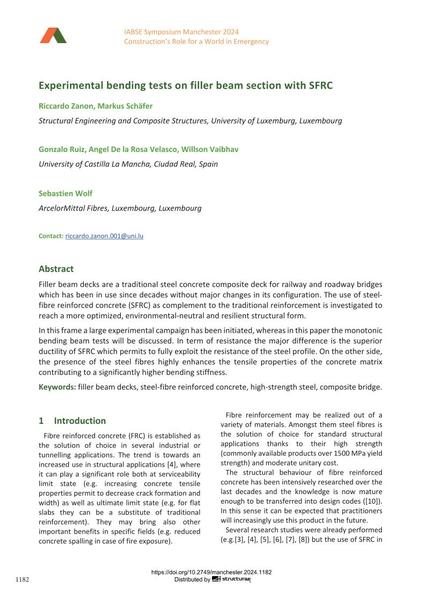Experimental bending tests on filler beam section with SFRC

|
|
|||||||||||
Bibliografische Angaben
| Autor(en): |
Riccardo Zanon
(Structural Engineering and Composite Structures, University of Luxemburg, Luxembourg)
Markus Schäfer (Structural Engineering and Composite Structures, University of Luxemburg, Luxembourg) Gonzalo Ruiz (University of Castilla La Mancha, Ciudad Real, Spain) Angel de la Rosa Velasco (University of Castilla La Mancha, Ciudad Real, Spain) Willson Vaibhav (University of Castilla La Mancha, Ciudad Real, Spain) Sebastien Wolf (ArcelorMittal Fibres, Luxembourg, Luxembourg) |
||||
|---|---|---|---|---|---|
| Medium: | Tagungsbeitrag | ||||
| Sprache(n): | Englisch | ||||
| Tagung: | IABSE Symposium: Construction’s Role for a World in Emergency, Manchester, United Kingdom, 10-14 April 2024 | ||||
| Veröffentlicht in: | IABSE Symposium Manchester 2024 | ||||
|
|||||
| Seite(n): | 1182-1188 | ||||
| Anzahl der Seiten (im PDF): | 7 | ||||
| DOI: | 10.2749/manchester.2024.1182 | ||||
| Abstrakt: |
Filler beam decks are a traditional steel concrete composite deck for railway and roadway bridges which has been in use since decades without major changes in its configuration. The use of steel- fibre reinforced concrete (SFRC) as complement to the traditional reinforcement is investigated to reach a more optimized, environmental-neutral and resilient structural form. In this frame a large experimental campaign has been initiated, whereas in this paper the monotonic bending beam tests will be discussed. In term of resistance the major difference is the superior ductility of SFRC which permits to fully exploit the resistance of the steel profile. On the other side, the presence of the steel fibres highly enhances the tensile properties of the concrete matrix contributing to a significantly higher bending stiffness. |
||||
| Stichwörter: |
Verbundbrücke
|
||||

